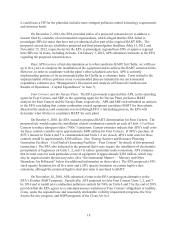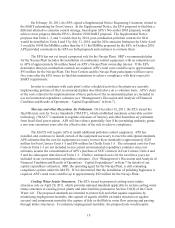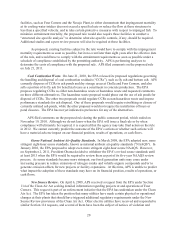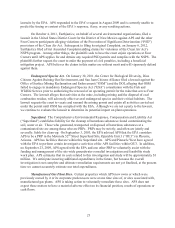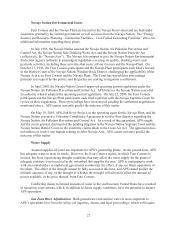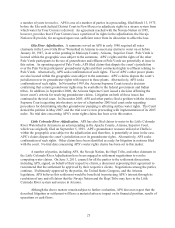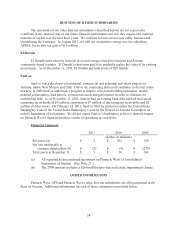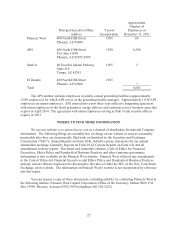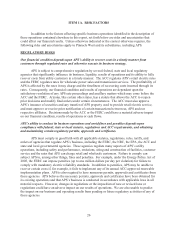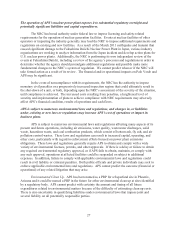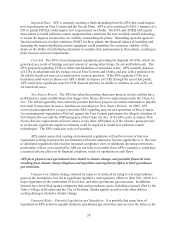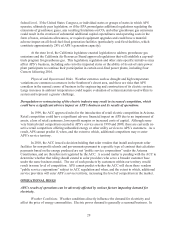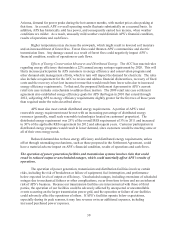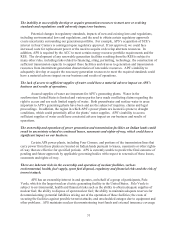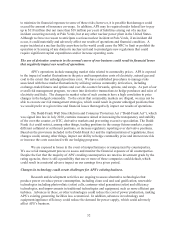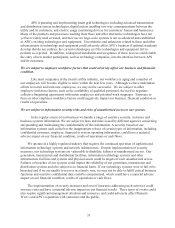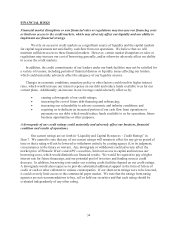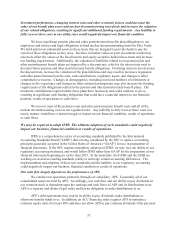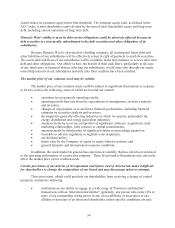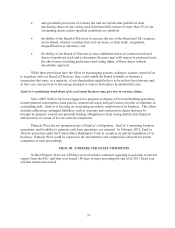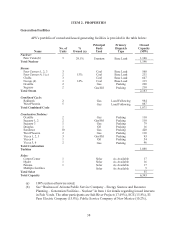APS 2011 Annual Report Download - page 52
Download and view the complete annual report
Please find page 52 of the 2011 APS annual report below. You can navigate through the pages in the report by either clicking on the pages listed below, or by using the keyword search tool below to find specific information within the annual report.28
Regional Haze. APS is currently awaiting a final rulemaking from the EPA that could impose
new requirements on Four Corners and the Navajo Plant. APS is also awaiting the EPA’s issuance of a
FIP or partial FIP that could impose new requirements on Cholla. The EPA and ADEQ will require
these plants to install pollution control equipment that constitutes the best available retrofit technology
to lessen the impacts of emissions on visibility surrounding the plants. Depending upon the agencies’
final determinations of what constitutes BART for these plants, the financial impact of installing and
operating the required pollution control equipment could jeopardize the economic viability of the
plants or the ability of individual participants to continue their participation in these plants, resulting in
plant closures and asset impairments.
Coal Ash. The EPA released proposed regulations governing the disposal of CCRs, which are
generated as a result of burning coal and consist of, among other things, fly ash and bottom ash. The
EPA proposed regulating CCRs as either non-hazardous or hazardous waste. APS currently disposes
of CCRs in ash ponds and dry storage areas at Four Corners and Cholla, and also sells a portion of its
fly ash for beneficial reuse as a constituent in concrete products. If the EPA regulates CCRs as a
hazardous solid waste or phases out APS’s ability to dispose of CCRs through the use of ash ponds,
APS could incur significant costs for CCR disposal and may be unable to continue its sale of fly ash
for beneficial reuse.
New Source Review. The EPA has taken the position that many projects electric utilities have
performed are major modifications that trigger New Source Review requirements under the Clean Air
Act. The utilities generally have taken the position that these projects are routine maintenance and did
not result in emissions increases, and thus are not subject to New Source Review. In 2009, APS
received and responded to a request from the EPA regarding projects and operations of Four Corners.
An environmental organization filed suit against the Four Corners participants for alleged violations of
New Source Review and the NSPS programs of the Clean Air Act. If the EPA seeks to impose New
Source Review requirements at Four Corners or any other APS plant, or if the citizens’ group prevails
in its lawsuit, significant capital investments could be required to install new pollution control
technologies. The EPA could also seek civil penalties.
APS cannot assure that existing environmental regulations will not be revised or that new
regulations seeking to protect the environment will not be adopted or become applicable to it. Revised
or additional regulations that result in increased compliance costs or additional operating restrictions,
particularly if those costs incurred by APS are not fully recoverable from APS’s customers, could have
a material adverse effect on its financial condition, results of operations or cash flows.
APS faces physical and operational risks related to climate change, and potential financial risks
resulting from climate change litigation and legislative and regulatory efforts to limit greenhouse
gas emissions.
Concern over climate change, deemed by many to be induced by rising levels of greenhouse
gases in the atmosphere, has led to significant legislative and regulatory efforts to limit CO2, which is a
major byproduct of the combustion of fossil fuel, and other greenhouse gas emissions. In addition,
lawsuits have been filed against companies that emit greenhouse gases, including a lawsuit filed by the
Native Village of Kivalina and the City of Kivalina, Alaska against us and several other utilities
seeking damages related to climate change.
Financial Risks – Potential Legislation and Regulation. It is possible that some form of
legislation or EPA action to regulate domestic greenhouse gas emissions may occur in the future at the


